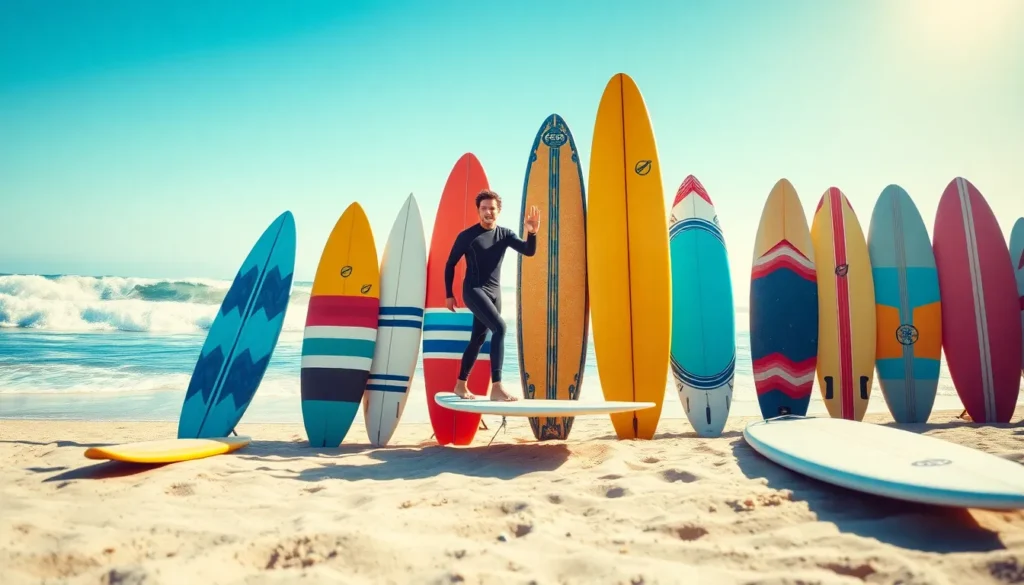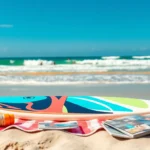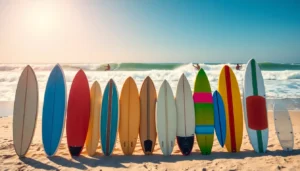
If you think all surfboards are created equal, think again. Choosing the right surfboard can make the difference between riding the perfect wave and a face-full of foam. Surfboards come with various shapes, sizes, and materials, all tailored to fit personal preferences and skill levels. Whether you’re an aspiring wave warrior or a seasoned surfer, understanding these nuances can propel your surfing experience to new heights, or at least help you avoid the embarrassment of being washed up on the beach. So grab your sunscreen and let’s jump into this essential guide.
Surf Boar

Surfboards can be as diverse as the beaches they ride on. Here’s a closer look at some popular types:
Shortboards: Performance and Maneuverability
When it comes to versatility in the water, shortboards reign supreme. Typically 5 to 7 feet long, these boards are designed for quick turns and agility. The narrower nose and tail allow for extreme maneuverability, making shortboards ideal for those who want to master tricks and perform sharp turns. They often suit more experienced surfers as they require a good balance and technique to ride effectively.
Longboards: Stability and Nostalgia
For those who crave a more balanced ride and enjoy a touch of nostalgia, longboards are the clear choice. Ranging from 8 to 12 feet, these boards offer stability and are perfect for cruisers who prefer smoother waves. The wider nose and curved tail make them optimal for nose riding and enjoying laid-back sessions. The longboard scene often harks back to surfing’s golden age, which adds an extra layer of charm for enthusiasts.
Fish Boards: Versatile and Fun
Fish boards, typically shorter with a wider outline, cater to surfers seeking fun without sacrificing performance. These boards perform admirably in smaller waves and are perfect for those just getting into the sport. With their unique shape, they offer the thrill of shortboarding but with a bit more stability, making it easy to catch waves while carving out some fun turns.
Paddle Boards: The Hybrid Option
Paddle boards present an exciting hybrid alternative for surfers looking to expand their horizon. Known for their wide stance and buoyancy, these boards cater not only to surfing but also to flat-water paddling and fitness activities. Their versatility makes them popular among surfers looking to enjoy leisurely ocean trips or to supplement their skills on calmer waters. Whether you want to glide quietly across a lake or catch some surf in the ocean, a paddle board can serve both purposes, making it a fantastic addition to any board collection.
Materials and Construction Techniques
Understanding the materials used in surfboard construction can directly improve your surfing experience. Here’s a breakdown:
- Polyester Resin: This is the most common material found in surfboards. It offers a beautiful finish and is relatively cheap to produce, but it does not weather the elements as well as other materials.
- Epoxy Resin: Known for its strength and durability, epoxy can withstand a beating and flexes more than polyester. Boards made from this material are often lighter and more buoyant, making them easier to maneuver.
- Expanded Polystyrene (EPS): Many modern boards incorporate EPS foam, which is lighter and provides excellent buoyancy. This makes it a popular choice for those looking for performance improvements.
Each material has its strengths and weaknesses, so considering your personal surf style can guide you toward the board that’s right for you.
Choosing the Right Surf Board for Your Skill Level
Selecting the right surfboard depends heavily on your surf proficiency:
- Beginners: Those new to surfing should opt for wider boards, such as longboards or soft-top boards, as their added stability will help instill confidence.
- Intermediate Surfers: With a bit of experience under their belts, intermediate surfers can transition to fish boards or shortboards. These boards provide enough versatility to enhance their skills without jumping too far out of their comfort zone.
- Advanced Surfers: Once adept at manipulating different board types, advanced surfers can explore a multitude of shortboards to refine their style even further. Their ability to handle various wave conditions makes shorter boards an attractive option.
Maintenance Tips for Longevity
To keep your surfboard in tip-top shape, regular maintenance is vital. Here are some simple yet effective tips:
- Rinse after Use: Always rinse your board with fresh water after a surf session to remove salt, sand, and debris.
- Store Properly: Avoid leaving your board in direct sunlight for extended periods. Instead, store it in a cool, shaded area to maintain its integrity.
- Check for Damage: Regularly inspect your board for dents or cracks. The sooner you address any issues, the longer your board will last.
- Wax It Up: Regularly apply wax to your board to maintain grip and prevent slippage. A well-waxed board enhances performance.












